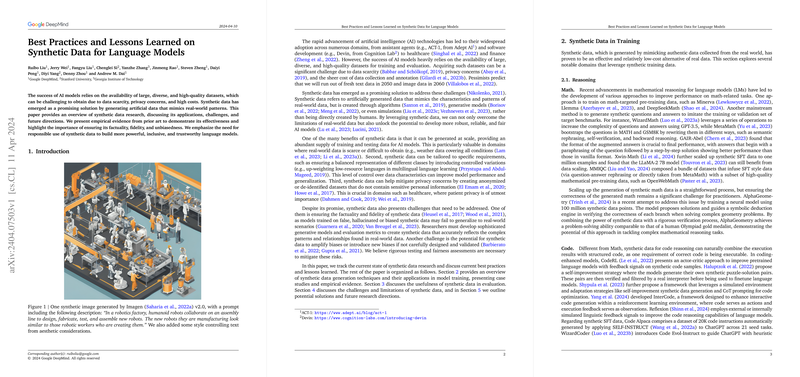Exploring the Frontiers of Synthetic Data in AI Development
Introduction to Synthetic Data
The landscape of AI technology is ever-evolving, with synthetic data taking center stage as a pivotal solution to the challenges of data scarcity, privacy issues, and the steep costs associated with data acquisition and annotation. Synthetic data, crafted through algorithms, generative models, or simulations, mirrors the properties of real-world data, holding the promise to refine AI models significantly. Despite its potential, the pursuit of authentic synthetic data generation is fraught with challenges in ensuring data factuality, managing biases, and maintaining fidelity.
Synthetic Data Utilization in Model Training
Applications Across Domains
- Mathematical Reasoning: Noteworthy advancements have been achieved in LMs for math-related tasks through synthetic question-answer generation. Despite the straightforward process of scaling synthetic math data, verifying its accuracy remains a considerable hurdle.
- Code Reasoning: In contrast to math, code reasoning benefits from the executable nature of code, offering a natural combination of code with execution results. Techniques like actor-critic approaches and self-improvement strategies have showcased substantial progress in this sphere.
- Tool-use Learning and Planning: Synthetic trajectories have shown promise in teaching LMs tool-using capabilities, highlighting models like LaMDA and Toolformer. Similarly, synthetic environments have aided LLMs in learning complex planning tasks with a considerable level of autonomy.
- Multi-modal Data Generation: From reverse rendering of images to text to multi-modality instruction following, synthetic data has demonstrated its utility in generating high-quality, diverse datasets that facilitate advanced model training.
Evaluating Synthetic Data's Role
The application of synthetic data extends beyond training to evaluation, where it serves crucial roles in assessing factuality, safety, and the overall performance of AI models. Techniques have evolved from basic statistical measures to more sophisticated model-based and real-time simulation methods, substantially enriching the evaluation landscape.
Challenges and Future Directions
The utilization of synthetic data is not without its pitfalls. Concerns range from the potential proliferation of misinformation and ambiguities in AI alignment to complications in evaluation decontamination. Future explorations are necessitated in several areas:
- Quality and diversity improvements in synthetic data generation, aiming for high fidelity and real-world resemblance, with attributes that closely mimic target domains.
- Efficient scalable oversight that utilizes synthetic data for robust monitoring of AI systems, addressing the need for comprehensive governance frameworks.
Conclusion
Synthetic data harbors transformative potential for AI development, offering a versatile solution to several longstanding challenges. It amplifies the capacity to generate abundant, diverse, and controlled training datasets while navigating the complexities of privacy and ethical considerations. Looking ahead, the focus on refining generative techniques will be paramount in harnessing the full spectrum of synthetic data’s benefits, ensuring AI models are more robust, inclusive, and aligned with human values and societal norms. As the AI community delves deeper into the realms of synthetic data, the journey is marked with challenges, yet buoyed by an undercurrent of significant promise and potential.
